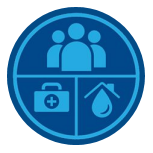
Tuberculosis Control Program

Helpful Printables
How the Seneca County TB Control Program serves the population of Seneca County:
– Provides Tuberculin Skin Testing
– Processes intakes, referrals and investigations for all suspected TB cases
– Clinical consultation at TB clinic
– Treatment and extensive education and follow up
– TB Exposure Control
– Directly Observed Therapy
– Nursing visits when necessary
Tuberculosis is a highly infectious disease that mainly affects the lungs, but it can attack any part of the body such as the throat, kidney, spine, or brain. The bacteria that causes TB (Mycobacterium Tuberculosis or tubercle bacilli) is spread through tiny droplets in the air when a person with active TB disease in their lungs speaks, coughs, sneezes, or sings.
People nearby may breathe in these bacteria and unknowingly become infected. However, not everyone infected with TB bacteria becomes sick. As a result, two TB related conditions exist: ‘latent TB infection’ and ‘active TB disease’.
Both types of TB are treated with long course antibiotics. Under Public Health Law the Public Health Department is mandated to monitor and manage all tuberculosis cases of residents in Seneca County. Cases of active and latent TB disease are reported to the department by physicians, hospitals and laboratories.
Our TB Control Program is staffed with a full-time nurse and case worker. Dr. Eric Shives is our contract TB physician. The goal of the Tuberculosis Control Program is to decrease the incidence of TB in Seneca County through effective screening, health education, outreach to those at risk and appropriate treatment.
*Interpreters are available for individuals who need them to assist with interviews.
Latent Tuberculosis Infection (LTBI)
People who are infected but not sick have what is called latent TB infection. They do not feel sick, do not have any symptoms, and, most importantly, they cannot spread tuberculosis germs to others. The only way we know they have latent TB infection is by their positive TB skin test or blood test and a negative chest x-ray.
Many people who have latent TB infection never develop active TB disease. However, in roughly 10-20% of those with latent TB, the bacteria become active, multiply, and cause TB disease. It is recommended that some individuals with latent TB infection receive treatment to prevent progression to active TB disease.
Active TB Disease
Symptoms of active TB disease include weakness, fever, chills, chest pain, decreased appetite, weight loss, lingering cough, and night sweats. TB disease is spread by close or repeated contact with a person who has active TB disease. When a person with active TB disease of the lungs speaks, coughs, sings, or sneezes, infectious tuberculosis droplets in the air can be inhaled by individuals nearby.
All residents with active TB disease are closely followed by a public health nurse who provides case management services, nursing assessment, medication management, and education. It is mandated that those with active TB disease are directly observed by a nurse while taking their medication. This is called Directly Observed Therapy (DOT). This is a proven way to ensure all medications are taken as prescribed.
Tuberculin Skin Testing (TST/PPD)
Seneca County Public Health administers TB skin tests for the public by appointment. Individuals working or volunteering in the health care field could be required to have this test annually based on employer policy. Other groups of people screened for TB infection include immigrants from countries with high incidence of TB, incarcerated individuals, some college students, and those who had recent contact with a person with active TB disease.
Seneca County Health Department
2465 Bonadent Drive – Suite 3 • Waterloo, NY 13165
Public Health: (315) 539-1920
Environmental Health: (315) 539-1945


